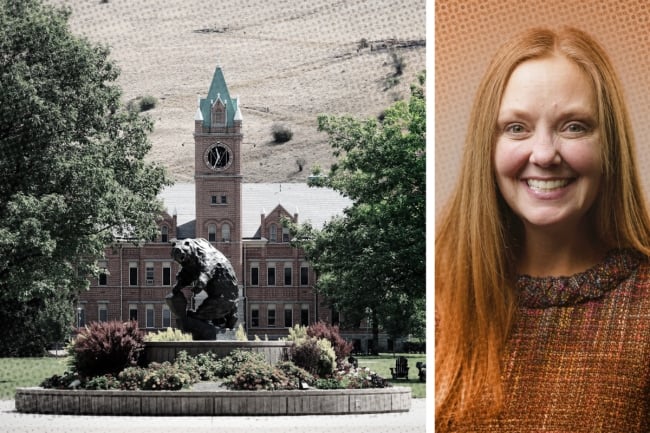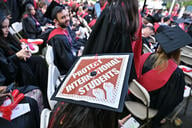You have /5 articles left.
Sign up for a free account or log in.

The University of Montana hired Leslie Webb to serve as the vice provost of student success and campus life just over a year ago. Webb spoke about her experiences leading at the institution and how she connects with students.
UCG/Universal Images Group Editorial/Getty Images | University of Montana
Leslie Webb credits a peer intervention with helping her get on track with her undergraduate studies and eventually build a career in higher education. Webb, who earned a bachelor’s degree in theater arts from Central Washington University, was more focused on her social life than her academics her first term, and it was a resident adviser who pulled her aside and showed concern for her success.
That interaction, coupled with a 1.9 GPA, gave Webb a wake-up call and set her on her path toward getting involved in student affairs.
Now the vice provost for student success and campus life at the University of Montana, Webb believes in fostering feelings of belonging among all students to promote student success, particularly through peer engagement opportunities.
Webb spoke with Inside Higher Ed about her first year in the role, her philosophy for student success and the importance of the student voice.
Q: What is your role, what’s included in your purview and how does that fit into the institutional vision for student success?
A: In this particular role, I support about 20-plus departments, more than 300 staff, a $68 million budget. The areas that I provide support to, I will break them down into three sort of categories: academic support services—so everything from academic advising to career services to new student programs to the writing center, TRIO programs—to our student engagement areas, so supporting students with underrepresented backgrounds, American Indian students’ services, really the areas that provide mattering and belonging for students. Those [two] functional areas, and then auxiliaries, traditional and nontraditional auxiliary—everything from campus rec, dining, housing, our health center, counseling, medical, we have dental [services].
Every unit is hyperfocused on student success, retention and how we contribute to postgraduate outcomes.
And then, of course, the third component is [how] all that work connects to the recruitment of new and prospective students and their families. But we focus on these other pieces first, because we want to make sure we’re delivering on the promise, and for me, I need to know who we’re not serving.
Q: What does that mean, “who we’re not serving”?
A: Technically, it’s disaggregating data in the cohort—from first to second year, who did not come back, and really understanding, what was that about? What were the primary factors? Was it around unmet need? Was it around mattering and belonging? Was it around these other things that have emerged in our world, life? Things have changed around us, the world has changed around us and our students and our staff and our faculty, they have all these pieces and parts, and so those things are prioritized.
Anyway, what does that mean? It’s around disaggregating the data and really understanding who we’re not serving, because for me, that’s the moral imperative.
Q: How does your role break down cross-functional barriers or silos in the institution?
A: That’s my huge focus. There’s a couple of things that I try to model out in front. For example, to the team of 20-plus that I support directly, I tend to say things like, “Every conversation is an opportunity to put a plank in the bridge, to extend an olive branch. Please look at every conversation and every interaction as an opportunity to bring people together. Collaborate, coordinate and align.”
“Coordinate” and “align” are two words that I use for almost everything. Everything that we do, to make sure that we’re all undergirding the academic and educational mission.
Our most common focus is that we’re serving the academic—and I add educational, just because education happens all over the place—that’s the commonality that defines that. It’s not about, “We teach, too”—it’s not a competition. We serve the academic and educational mission in these ways.
I’m a year and a half in, so folks are still getting used to my disposition and my methodology, and maybe it’s a little less directive than it is modeling, leading and being present in the work with colleagues.
I have more direct reports than I would probably normally have because I’m missing a few key positions. I’m in … the weeds and I’m okay with that—not in a micromanager way, I don’t want to suggest that—but it is really just about being in community with the people that you support, and leading them to see how we’re all in this work together.
I’m really trying to think about, what are the most meaningful ways, in order to create collaborative relationships with faculty, that might not be the most natural thing? So is it going to the executive committee of … the Faculty Senate, reaching out to faculty, helping them to understand how our demographics have changed? There’s myriad ways to do that. Everything that I do is [an] attempt to coordinate and align.
Q: What is your philosophy for student success?
A: I know that we are talking about this all the time. I know that we say, “How does how do students feel like they matter and that they belong and that they’re contributing to their community, they’re part of something bigger than themselves?” Like, those are all the … catchphrases.
But underneath all of the metrics that we look at, and all the things we’re trying to do, is a feeling. Which is, like, “ooh, ooh,” but a feeling that a student has about their place.
The feeling that a student has matters almost more than anything, because a feeling pushes you through that glitch with that system, that maybe not perfect interaction with that employee—faculty, staff, doesn’t matter who—or a social situation in the residence hall that didn’t go as perfectly right. But the feeling that one has is the thing that will push them through whatever adversity they’re facing. And that’s really hard to describe.
Q: How do you live out that work practically or how is that built into your goals?
A: We are incredibly committed to framing what it means to be a student here. There are so many things going on, on campus and in the community. And I’m trying to capture that and help a student see that this place is for them, regardless of intersecting identities, regardless of affiliations, regardless of ideologies. Doing that in a way that helps every student—which is tricky, tricky to do—but helps everyone to see themselves.
An example that I’ll share, because it was recent: our forestry students turn an entire old school gymnasium into a historic [logging] town. This tradition has been going on since 1917 at the university. When I go and watch the Foresters’ Ball and 200-ish students were lined up doing the same dance, those students didn’t even know each other—some did—but they all came from organizations all across the institution, different majors, different walks of life, different parts of the country, to build and then participate in this incredible ball that has roots down to the institution’s history that are so deep and so historic.
Students are creating opportunities for students to come together. Regardless of this list of things that contribute to identity, [that] is significantly important. I can curate 1,000 things for students, but when it’s curated by the students, it is far more attractive.
Q: As a new administrator, how do you get a pulse on student life?
A: It’s funny, I just wrote a blog about aging in the workplace … and when to put a fork in it, like, “Girlfriend, you’re no longer in tune” … I spent this time in this blog for NASPA reflecting on how one stays relevant, how one stays connected, and that it’s so important to do so.
So for me, the way that I do that is by going to Student Government every Wednesday night, by being an adviser to students or student organizations … I try and push through that every single day and make sure that I have relationships with students and staff so that they see me, so I’m humanized. I’m not just admin, I’m Leslie, who has “student” in their title, sits at the cabinet, but represents students.
For me, it’s really important to be in community with students, understand the pain points, understand what’s going well, and I do that just by being in their worlds … Any time I get the opportunity to be in community with students, that’s how I keep my finger on the pulse. Because we can get stuck in here, grinding away in our admin world. I really make a concerted effort to be in community with students.
Sometimes we think—we, the people with the degrees and the experience and 25 years of blah, blah, blah—that we’re the experts. I’m not going to say that we’re not, but the best expert in the student experience is the student. They are experts in their experience, even if they don’t see that they are experts in it. [To] really leverage that, to remind them of that, gives them agency and voice that they might not have.
But when we sort of bridge between admin and students, that’s when I think the real learning happens. When they feel welcome to share their perspective and their feedback and their stories.
Do you work with a student success champion, a campus leader with student success as part of their job title? Nominate your colleague for an upcoming Q&A article.




